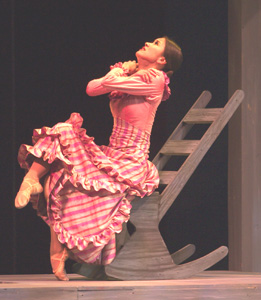![[Metroactive Stage]](/stage/gifs/stage468.gif)
[ Stage Index | Silicon Valley | Metroactive Home | Archives ]

Photograph by Robert Shomler Pioneer Pose: Sayaka Tai danced Martha Graham's ritualized idea of 19th-century rural marriage in 'Appalachian Spring.' Mastering Martha Ballet San Jose Silicon Valley revived Martha Graham's 'Appalachian Spring' with uncorrupted symbolism By Scott MacClelland REVIVING THE ORIGINAL Appalachian Spring is like a reunion of separated lovers. Though Martha Graham's choreography remained faithful, Aaron Copland's music has led a profligate life of its own since shortly after the premiere in 1944. Still, Ballet San Jose Silicon Valley gamely mounted a revival of the all-American masterpiece last weekend, revealing at least two qualities, for better or worse, that go with its infrequent appearance on the stage. One, the influential Graham originality now shows its age. And two, the deceptively simple, original 13-instrument score needs more preparation than meets the eye. For the occasion, company artistic director Dennis Nahat engaged Graham disciple Yuriko to stage and direct the production. This vouchsafed the authenticity of the original and held at bay any temptation to corrupt "mirthless Martha," as Copland described her. Graham's work is ultimately symbolic, ritualistic, neither realistic in the photographic sense, nor abstract. Her sexuality is as palpable as the stark sensuality of its appearances, and often reminds one of Georgia O'Keeffe's close-up portraits of flowers. With Graham's "pelvic truth" in mind, Sayaka Tai appeared as the Bride, increasing the character's impact with youthful exuberance. The role of the Husbandman was taken by James Strong, as forthright a portrayal as his name suggests. Jenni Chiarelli and Daniel Gwatkin danced the archetypal Pioneering Woman and Revivalist, and the followers, in their white bonnets, were Christina Hall, Maria Jacobs, Mirai Noda and Rika Onizuka. Solos and ensembles alternated between high-energy leaps and scurrying, and dramatic but static posing. (Gwatkin's "anguish" solo was memorably expressive.) As a narrative allegory of rural life in early-19th-century rural Pennsylvania, the piece seems old-fashioned, not so much as a portrait of an America now all but lost but caught in that stage conceit where characters either participate or spectate, but not both at the same time. This is the one flaw in Graham's artistic philosophy that, though solved in her solo works, remains a conundrum in several of her ensemble pieces. Cheers to the dancers and the company for the revival, nevertheless. Doubts, however, for conductor Dwight Oltman and his small orchestra for their lack of precision in the transparent and colorful but ultimately austere score. The program Saturday night opened with Michael Smuin's Stravinsky Piano Pieces, with pianist Roy Bogas anchoring the parade of characteristic dances from downstage right. With typical flair, Smuin turns study vocabulary into performance material without apology. Starting at the barre, the movements alternate tempi and rhythms, from tango to tap, from solos to duos, from cool whimsy to passionate love, and even a Pilobolus-influenced contortion for one woman (Catherine Grow) and six men that, in its own way, pays homage to the sexual-without-being-sexy example of Graham. Not least memorable was the polka in which the precocious 9-year-old student Elaine Yu matched her fully professional partner Le Mai Lin move for move with similar ease and grace. Nahat's and Ian Horvath's US, a "cavalcade" of American dance over time, punctuated the evening as the company began with rural square dancing, then visited the turn of the (20th) century, the flapper era, the lush ballroom style of Nelson Riddle and Gordon Jenkins, the Dorsey sound, big-band rock of the '70s and popular street dance of own time. The last, revised with the latest crazes for each revival, used a "troupe" from the greater San Jose community and choreographed for the occasion. To say it was the showstopper is an understatement, the younger members of the audience screaming their approval. At last, the tour ended with a Rockettes-style ritual to "This Land."
Send a letter to the editor about this story to letters@metronews.com. [ Silicon Valley | Metroactive Home | Archives ]
|
From the October 23-29, 2003 issue of Metro, Silicon Valley's Weekly Newspaper.
Copyright © Metro Publishing Inc. Metroactive is affiliated with the Boulevards Network.
For more information about the San Jose/Silicon Valley area, visit sanjose.com.